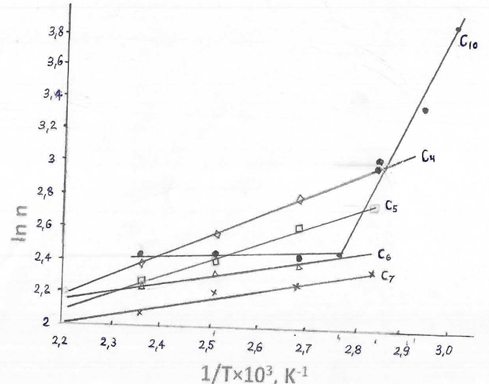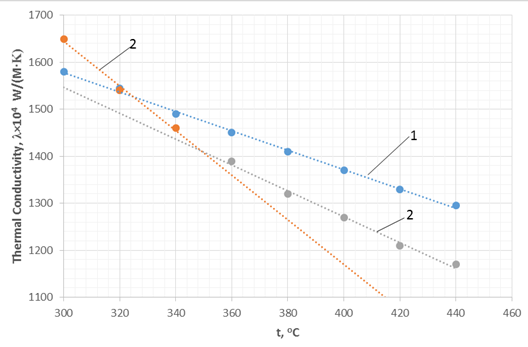Short Communication
Volume 4 Issue 1 - 2022
About the Penetration of Associates and Micelles into the Blood of Goldfish
Sintez Research Institute Russia, Moscow, 115 088
*Corresponding Author: B. Ya. Stul, Sintez Research Institute Russia, Moscow, 115 088.
Received: January 02, 2022; Published: January 12, 2022
In works /1,2/, the kinetics of the oxyethylation reaction of primary alcohols of the normal structure of the composition C4-C7 and C10 was studied. It is shown that in this reaction, not a monomeric alcohol molecule acts as a kinetically independent unit, but a linear chain alcohol associate consisting, on average, of n alcohol molecules. For alcohols C4-C7, the dependence of the parameter n on temperature is expressed in Arrhenius coordinates in the form of one straight line. For alcohol C10, this dependence is expressed by two straight lines with an intersection point of about 87,5°? (see figure 1). Above this temperature, the parameter n ≈ 11-12 and does not depend on temperature. At t < 87, 5°?, the rapid growth of parameter n begins. At t = 60°? n ≈50. Such values of the parameter n are characteristic not for associates, but for micelles. At t > 87,5°?, the interaction in associates is apparently carried out due to hydrogen bonds of hydroxyl groups. At lower temperatures, the Van der Waals interaction of hydrocarbon radicals is added to this interaction and the associate turns into a micelle.
We do not have data on alcohols C8-C9, but there are data in the literature on the dependence of the thermal conductivity of alcohols C6-C12 on temperature. In this work /3/ it is shown that for alcohols C6-C8 this dependence is expressed in the form of one straight line, and for alcohols C9-C12 in the form of two intersecting lines with intersection points in the region of 80-95°?. In Figure 2. These dependencies are shown for alcohols C8 and C10. If the analogy with thermal conductivity is correct, then alcohols C6-C8 form associates, and alcohols C9-C12 form micelles. If so, it leads to interesting physiological consequences.
In the work /4/ the anesthetic effect of alcohols C6-C12 on Goldfish fish was investigated. A certain concentration of a certain alcohol was created in the aquarium. Fish were launched there and the concentration of alcohol in the fish's blood was monitored. In Figure 3 the results obtained after 20 minutes at an alcohol concentration in water of 12.5 ppm are shown. It can be seen from the figure that alcohols forming micelles penetrate into the blood of fish faster than alcohols forming associates, and have a correspondingly greater anesthetic effect /4/.
Thus, in the body of the fish there is, relatively speaking, a filter makes it difficult the penetration of alcohols forming associates into the blood of the fish (hydrocarbon radicals are dissolved) and passes alcohols forming micelles into the blood (hydrocarbon radicals are interconnected).

Figure 1: Dependences of parameter n on temperature for alcohols C4-C7 /1/ and C 10 /2/ in Arrhenius coordinates.

Figure 2: The dependence of the thermal conductivity of alcohols C8 (1) and C10 (2) on the temperature / 3/.
References
- B. Ya. Stul’ and B. B. Chesnokov, Kinet. Catal. 43, 741, (2002)
- B. Ya. Stul’ (2016). Russian Journal of Physical Chemistry A, Vol. 90, No. 4, pp. 754–760.
- M.M.Bashirov, Y.M.Naziev. (2003). Novosti Azerbaydzhanskoy Nauchnoy Akademii, seriya fiziko-matematicheskikh i tekhnicheskikh nauk, ?2, ?.124.
- L.Eshqaidef, E.Wliamsen, J. Sidie, Departament of Chemistry and Biology, Ursinus College. 601 E.Main St., Colegevile. PA 19426
Citation: B. Ya. Stul. (2022). About the Penetration of Associates and Micelles into the Blood of Goldfish. Journal of Pharmacy and Drug Development 4(1).
Copyright: © 2022 B. Ya. Stul. This is an open-access article distributed under the terms of the Creative Commons Attribution License, which permits unrestricted use, distribution, and reproduction in any medium, provided the original author and source are credited.

